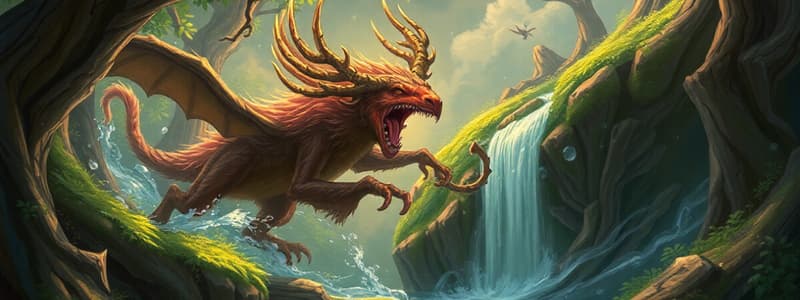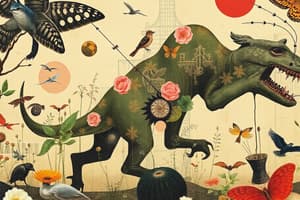Podcast
Questions and Answers
Which of the following best describes the relationship between a lion and a zebra?
Which of the following best describes the relationship between a lion and a zebra?
- Predation, where the lion benefits and the zebra is harmed. (correct)
- Mutualism, where both organisms benefit.
- Competition, where both organisms compete for the same resources.
- Commensalism, where one benefits and the other is unharmed.
In a commensalism relationship, both individuals benefit from the interaction.
In a commensalism relationship, both individuals benefit from the interaction.
False (B)
What term describes the transfer of pollen grains by a bee, where both the bee benefits by extracting nectar and the plant benefits through reproduction?
What term describes the transfer of pollen grains by a bee, where both the bee benefits by extracting nectar and the plant benefits through reproduction?
mutualism
An ecosystem comprises both ______ and non-living components interacting within a specific area.
An ecosystem comprises both ______ and non-living components interacting within a specific area.
Match the following organisms to their nutritional role in an ecosystem:
Match the following organisms to their nutritional role in an ecosystem:
What is the primary role of decomposers in an ecosystem?
What is the primary role of decomposers in an ecosystem?
Autotrophic organisms depend on other organisms to obtain their food.
Autotrophic organisms depend on other organisms to obtain their food.
What type of living organism is classified into herbivore, carnivore, omnivore, and scavenger categories based on their diet?
What type of living organism is classified into herbivore, carnivore, omnivore, and scavenger categories based on their diet?
A ______ is an animal that primarily eats meat.
A ______ is an animal that primarily eats meat.
Match each animal with its dietary classification:
Match each animal with its dietary classification:
What does a food chain represent?
What does a food chain represent?
A 'food web' illustrates a single, linear path of energy flow in an ecosystem.
A 'food web' illustrates a single, linear path of energy flow in an ecosystem.
What term is used to describe each stage in a food chain where energy is transferred?
What term is used to describe each stage in a food chain where energy is transferred?
A terrestrial food chain starts with a ______ as the primary producer.
A terrestrial food chain starts with a ______ as the primary producer.
Match the food chain type with its environment:
Match the food chain type with its environment:
In an energy pyramid, what happens to the amount of energy available at each successive trophic level?
In an energy pyramid, what happens to the amount of energy available at each successive trophic level?
In an energy pyramid, the base of the pyramid represents Tertiary Consumers.
In an energy pyramid, the base of the pyramid represents Tertiary Consumers.
What percentage of energy, approximately, is transferred from one trophic level to the next?
What percentage of energy, approximately, is transferred from one trophic level to the next?
The use of living organisms to control pests in agriculture is known as ______ Control.
The use of living organisms to control pests in agriculture is known as ______ Control.
What is the likely outcome if the number of secondary consumers decreases in an ecosystem?
What is the likely outcome if the number of secondary consumers decreases in an ecosystem?
Flashcards
Ecosystem
Ecosystem
A community of living organisms (biotic) interacting with each other and with their non-living (abiotic) environment.
Biological community
Biological community
A group of different species living and interacting in the same area.
Biotic population
Biotic population
A group of individuals of the same species living in the same area.
Individual organism
Individual organism
Signup and view all the flashcards
Predation
Predation
Signup and view all the flashcards
Competition
Competition
Signup and view all the flashcards
Mutualism
Mutualism
Signup and view all the flashcards
Commensalism
Commensalism
Signup and view all the flashcards
Autotrophs/Producers
Autotrophs/Producers
Signup and view all the flashcards
Heterotrophs/Consumers
Heterotrophs/Consumers
Signup and view all the flashcards
Decomposers
Decomposers
Signup and view all the flashcards
Herbivores
Herbivores
Signup and view all the flashcards
Carnivores
Carnivores
Signup and view all the flashcards
Omnivores
Omnivores
Signup and view all the flashcards
Scavengers
Scavengers
Signup and view all the flashcards
Food Chain
Food Chain
Signup and view all the flashcards
Food Web
Food Web
Signup and view all the flashcards
Biological Control
Biological Control
Signup and view all the flashcards
Energy Pyramid
Energy Pyramid
Signup and view all the flashcards
Study Notes
- An ecosystem consists of living and non-living organisms.
- A biological community is a group of different species in an ecosystem.
- A biotic population is a group of the same species.
- An individual is a single living organism.
Nutritional Relationships
- Predation is a relationship where one organism (predator) benefits and the other (prey) is harmed.
- Example: Zebra and lion; chameleon and insects; dionea (venus flytrap) and insects.
- Competition occurs when two individuals of the same species compete for limited resources like food, growth, and survival.
- Example: Two lions competing for a zebra.
- When competition increases, the number of individuals decreases.
- Mutualism involves both individuals benefiting.
- Example: A bee extracting nectar from a plant, while the plant benefits from pollen transfer for reproduction.
- Commensalism is when one individual benefits and the other is neither benefited nor harmed.
- Example: Plover bird cleaning crocodile teeth.
Living Organism Classification
- Living organisms are classified into producers, consumers, and decomposers.
- Producers (autotrophs) can make their own food, such as plants and algae.
- Consumers (heterotrophs) depend on producers to get food; they are animals.
- Decomposers break down organic matter in dead bodies into simpler substances like fungi and bacteria.
Consumers Classification
- Consumers are further classified into herbivores, carnivores, omnivores and scavengers.
- Herbivores eat only plants, such as horses and rabbits.
- They have incisors (front teeth).
- Carnivores eat only meat, such as lions and snakes.
- They have sharp canines.
- Omnivores eat both plants and meat, such as bears, ravens, mice, and hedgehogs.
- Scavengers eat remains of dead bodies; for example, hyenas, eagles, and cockroaches.
Food Chains
- A food chain is the path of energy flow from one living organism to another: Producer → Consumer → Decomposer.
- A trophic level is each stage in which energy is transferred in a food chain.
Food Webs
- A food web is an interconnection of multiple food chains.
- Example: Grass → Rabbit → Snake → Eagle; Grass → Rabbit → Eagle → Fox.
Types of food chains
- Terrestrial food chains: found on land,
- Aquatic food chains: found in water. Algae (producer) → Copepod (primary consumer) → Fish (secondary consumer) → Seal (tertiary consumer) → Polar Bear (quaternary consumer).
- Desert food chains: found in deserts
Biological Control
- Biological control utilizes living organisms through the food chain to eliminate agricultural pests.
- Example: Using dotted beetles to eat aphids that harm fruits.
Food Webs
- Producers like grass and carrots.
- Primary consumers like birds, locusts, mice, and rabbits.
- Top predators like owls and foxes.
Ecological Balance
- Number of primary consumers increase:
- Producers will decrease.
- Number of secondary consumers decrease:
- Increase number of primary consumers
- Decrease number of tertiary consumers.
Energy Pyramid
- An energy pyramid represents the flow of energy.
- Tertiary
- Secondary Consumer
- Primary Consumer
- Producer
- Each trophic level gets 10% of the energy. 90% is lost.
- Example:
- Grass: 10000 Energy Unit
- Rabbit: 100 Energy Unit
- Snake: 10 Energy Unit
- Hawk: 1 Energy Unit
Studying That Suits You
Use AI to generate personalized quizzes and flashcards to suit your learning preferences.




